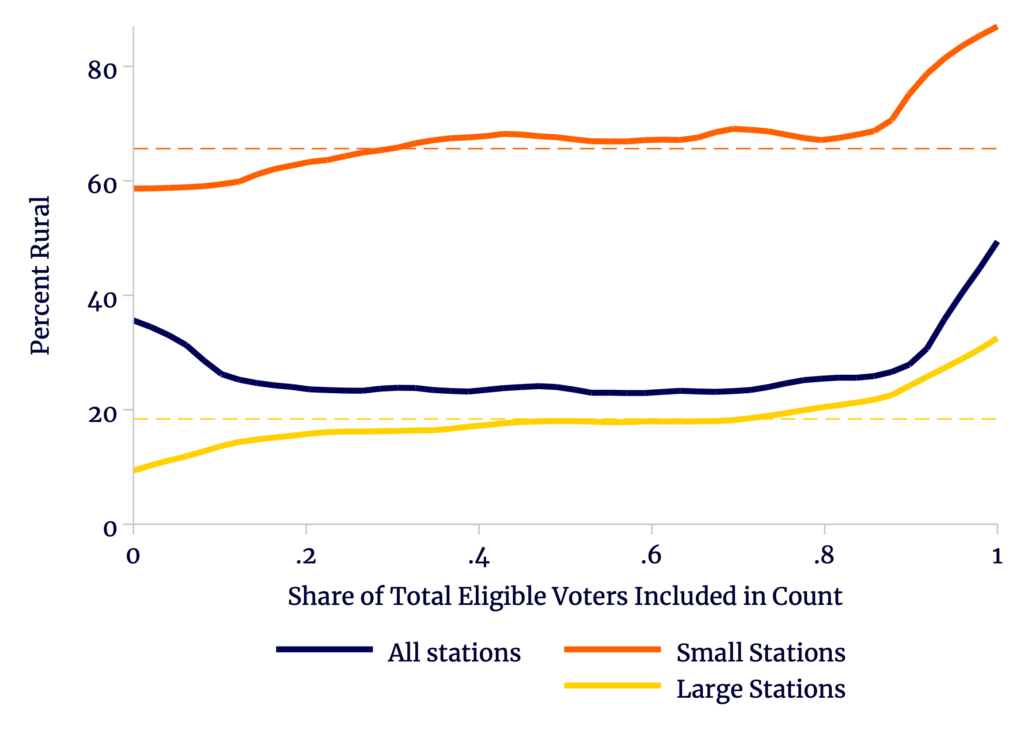November 15, 2022
This is the third in a series of blog posts addressing a report by Diego Escobari and Gary Hoover covering the 2019 presidential election in Bolivia. Their conclusions do not hold up to scrutiny, as we observe in our report Nickels Before Dimes. Here, we expand upon various claims and conclusions that Escobari and Hoover make in their paper. Links to other posts: part one, part two, part four, part five, part six, part seven, part eight, and part nine.
In our previous entry, we observed that a small bias in the order in which ballots are counted may mislead in our understanding of an election. Specifically, the tendency for one candidate’s votes to be considered in advance of another’s means that a partial count will not be representative of the entire electorate. Under very simple assumptions, what appears to be a stable overall trend may swing very sharply. Projections of the final results must not be naive and fail to account for considering nickels before dimes, lest the analyst is surprised by the final result.
In our example of biased counts, any vote for candidate B was14 percent more likely to be counted next when compared to any vote for candidate A. As a result, votes for A were about 16 percent more likely to be counted among the last one-sixth than they were among the first one-sixth. This was enough to throw off naive estimates of the election result based on partial reporting.
The preliminary count in Bolivia’s 2019 presidential election suffered from a similar kind of bias, and in the official count the bias was even worse. In the preliminary count, rural voters (which tended to strongly favor Morales) were 56 percent more likely to be counted in the last sixth than in the first. But in the official count, rural voters were nearly four times more likely to be counted in the last sixth than in the first. Nickels before dimes.
Of course, not all rural voters voted for Morales, nor did urban voters against. However, the early biases against rural voters are factors that must be completely accounted for in partial counts of the results. There were benign reasons for these biases to exist.
In the preliminary count, polling stations were included in approximately the same order that the results were transmitted to a central location via a phone app. This meant that rural areas lacking cellular coverage were delayed as the functionaries responsible for submitting the results waited to be ferried to locations with cellular coverage. Furthermore, poll workers were selected at random, and not all poll workers were well-trained. Those selected from poor and Indigenous communities have elevated levels of Spanish illiteracy and are less likely to have the kind of clerical experience that would facilitate the work of managing the polling station. According to the Electoral Observation Mission (EOM) of the Organization for American States:
69% of the tables observed had all of their official members, while 15% had to turn to voters who were in line. This last percentage is important given that the citizens who went on to serve at the tables had little or no knowledge about their role.
In addition, the EOM observed that the level of poll workers’ training was in most cases insufficient, forcing them to constantly turn to the election notary in order to carry out their duties. This became more acute at the time the polls were closing, during the vote tallying, and when the tally sheets were being filled out.
The EOM did not indicate if such problems were more prevalent in neighborhoods of a particular socioeconomic status, but even slight delays in reporting could easily bias the order of the count. At peak transmission, a delay of only five minutes would allow another 1,700 polling stations — almost 5 percent of the total — to report first.
The preliminary count results relied on electronic submissions. However, a polling station could not be included in the official count until results were hand-delivered to offices in the department capitals. This created a very strong, natural bias for precincts geographically close to the offices to be counted early. It requires little imagination to see that precincts only several city blocks away would deliver results very early, while precincts in remote and nearly inaccessible towns would deliver results very late. Voters in capital cities were 11 times more likely to have their polling stations included in the first sixth of the count than in the last sixth. And the capital cities, in particular, strongly opposed Morales.
There is another bias worth mentioning. Escobari and Hoover, in the right panel of their Figure 3, show that rural polling stations were disproportionately likely to transmit results both very early and very late.
Figure 1
Escobari and Hoover Show Many Rural Stations Reported Very Early and Very Late

Source: Escobari and Hoover (2020) Figure 3.
They speculate that the elevated rural share among the earliest reporters came from polling stations with relatively few votes to count. They nevertheless dismiss the “rural vote effect” as an artifact of decades past.
The “rural vote effect” (rural stations reporting later) is absolutely true, if masked in part by the small-station effect that disproportionately applied to rural precincts. Only 11 percent of eligible voters were assigned to polling stations with fewer than 215 total voters. Having fewer eligible voters, and therefore generally fewer votes to count (an average of 120 voters tuning out, compared to 201 for the larger stations) the small polling stations tended to submit their transcription of the results first. Compared to urban voters, rural voters were six times more likely to be assigned to one of these small polling stations, so on balance the earliest results were disproportionately rural. However, regardless of whether the station was small or large, the rural stations tended to transmit results later than urban stations.
The blue line of Figure 2 largely replicates Escobari and Hoover. Our numbers are a little higher because we restrict our analysis to polling stations located in Bolivia (Bolivians around the world may vote in Bolivian elections), but the story is the same: the earliest and latest reporters were disproportionately rural. Yet, separating stations into groups of small and large, we see rural stations tended to report late, regardless of size.
Figure 2
Among Both Small and Large Stations, Rural Stations Tended to Report Later

Source: author’s calculations.
This is an incomplete accounting for the biases involved in partial counts of the 2019 election. For now, it suffices to recognize that votes were not counted at random and that the problem of counting nickels before dimes is real and must be accounted for when the count is incomplete.
In the next post, we offer some background on the preliminary count and note how the problem of nickels before dimes created a misleading picture of the election — with fatal consequences.






